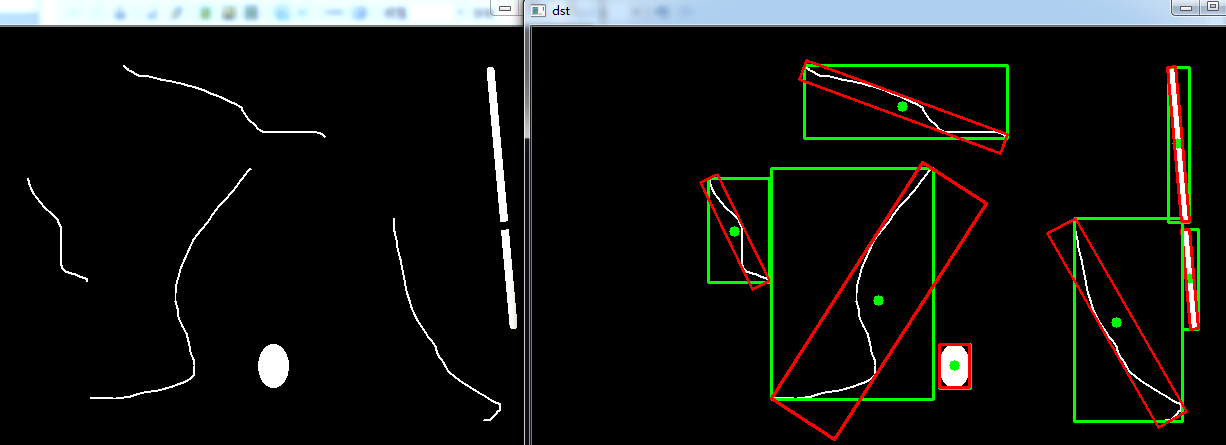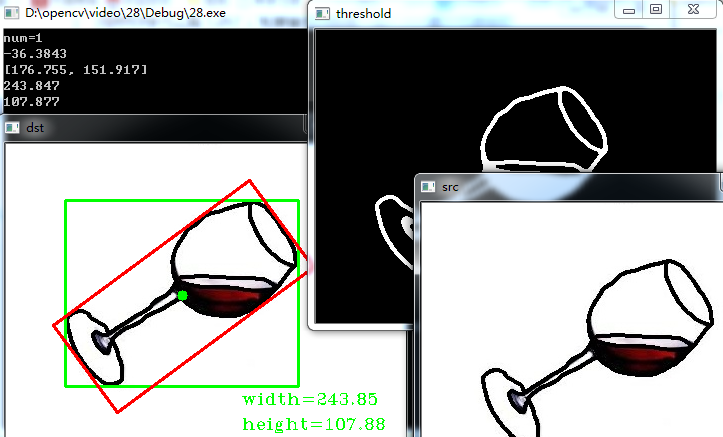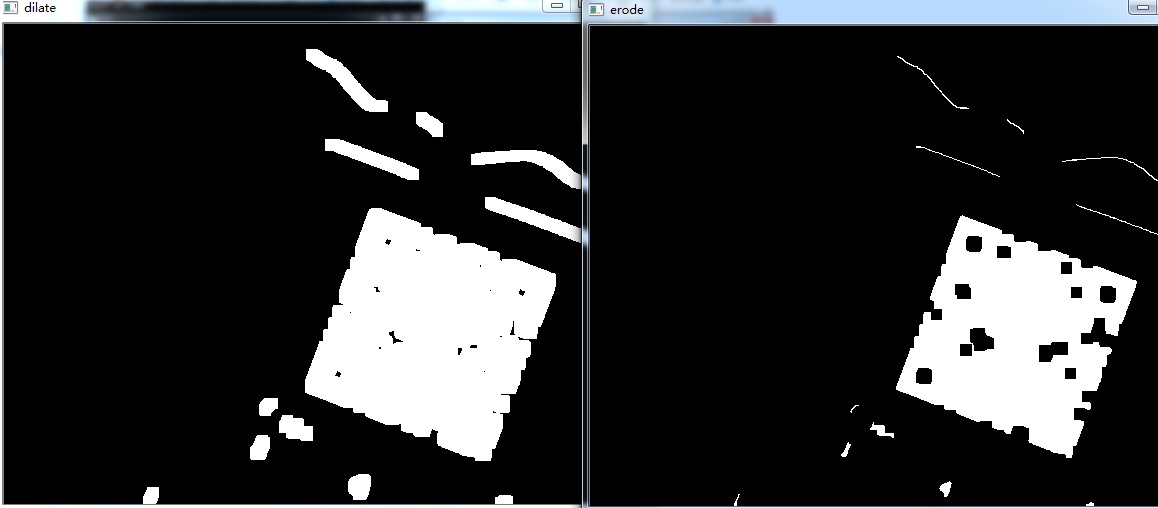一、简介

二、轮廓最小外接矩形的绘制
1 #include "opencv2/opencv.hpp"
2 using namespace cv;
3
4 void main()
5 {
6 //轮廓最小外接矩形的绘制
7 Mat srcImg = imread("E://00.png");
8 Mat dstImg = srcImg.clone();
9 cvtColor(srcImg, srcImg, CV_BGR2GRAY);
10 threshold(srcImg, srcImg, 100, 255, CV_THRESH_BINARY); //二值化
11 imshow("threshold", srcImg);
12
13 vector<vector<Point>> contours;
14 vector<Vec4i> hierarcy;
15 findContours(srcImg, contours, hierarcy, CV_RETR_EXTERNAL, CV_CHAIN_APPROX_NONE);
16 vector<Rect> boundRect(contours.size()); //定义外接矩形集合
17 vector<RotatedRect> box(contours.size()); //定义最小外接矩形集合
18 Point2f rect[4];
19 for(int i=0; i<contours.size(); i++)
20 {
21 box[i] = minAreaRect(Mat(contours[i])); //计算每个轮廓最小外接矩形
22 boundRect[i] = boundingRect(Mat(contours[i]));
23 circle(dstImg, Point(box[i].center.x, box[i].center.y), 5, Scalar(0, 255, 0), -1, 8); //绘制最小外接矩形的中心点
24 box[i].points(rect); //把最小外接矩形四个端点复制给rect数组
25 rectangle(dstImg, Point(boundRect[i].x, boundRect[i].y), Point(boundRect[i].x + boundRect[i].width, boundRect[i].y + boundRect[i].height), Scalar(0, 255, 0), 2, 8);
26 for(int j=0; j<4; j++)
27 {
28 line(dstImg, rect[j], rect[(j+1)%4], Scalar(0, 0, 255), 2, 8); //绘制最小外接矩形每条边
29 }
30 }
31 imshow("dst", dstImg);
32 waitKey(0);
33 }

三、粗略计算物体像素长宽
1 #include "opencv2/opencv.hpp"
2 #include<iostream>
3 using namespace std;
4 using namespace cv;
5
6 void main()
7 {
8 Mat srcImg = imread("E://cup.jpg");
9 imshow("src", srcImg);
10 Mat dstImg = srcImg.clone();
11 medianBlur(srcImg, srcImg, 5);
12 GaussianBlur(srcImg, srcImg, Size(3, 3), 0, 0);
13 cvtColor(srcImg, srcImg, CV_BGR2GRAY);
14 threshold(srcImg, srcImg, 100, 255, CV_THRESH_BINARY_INV); //INV是因为背景白色,物体黑色,需要反转一下
15 imshow("threshold", srcImg);
16
17 vector<vector<Point>> contours;
18 vector<Vec4i> hierarcy;
19
20 findContours(srcImg, contours, hierarcy, CV_RETR_EXTERNAL, CV_CHAIN_APPROX_NONE);
21 cout<<"num="<<contours.size()<<endl;
22 vector<Rect> boundRect(contours.size());
23 vector<RotatedRect> box(contours.size());
24 Point2f rect[4];
25 for(int i=0; i<contours.size(); i++)
26 {
27 box[i] = minAreaRect(Mat(contours[i]));
28 boundRect[i] = boundingRect(Mat(contours[i]));
29 cout<<box[i].angle<<endl;
30 cout<<box[i].center<<endl;
31 cout<<box[i].size.width<<endl;
32 cout<<box[i].size.height<<endl;
33 circle(dstImg, Point(box[i].center.x, box[i].center.y), 5, Scalar(0, 255, 0), -1, 8);
34
35 //绘制外接矩形和 最小外接矩形(for循环)
36 rectangle(dstImg, Point(boundRect[i].x, boundRect[i].y), Point(boundRect[i].x + boundRect[i].width, boundRect[i].y + boundRect[i].height), Scalar(0, 255, 0), 2, 8);
37 box[i].points(rect);//把最小外接矩形四个端点复制给rect数组
38 for(int j=0; j<4; j++)
39 {
40 line(dstImg, rect[j], rect[(j+1)%4], Scalar(0, 0, 255), 2, 8);
41 }
42
43 char width[20], height[20];
44 sprintf(width, "width=%0.2f", box[i].size.width);
45 sprintf(height, "height=%0.2f", box[i].size.height);
46 putText(dstImg, width, Point(235, 260), CV_FONT_HERSHEY_COMPLEX_SMALL, 0.85, Scalar(0, 255, 0));
47 putText(dstImg, height, Point(235, 285), CV_FONT_HERSHEY_COMPLEX_SMALL, 0.85, Scalar(0, 255, 0));
48
49 }
50 imshow("dst", dstImg);
51 waitKey(0);
52 }

四、倾斜物体矫正提取
1 #include "opencv2/opencv.hpp"
2 #include<iostream>
3 using namespace std;
4 using namespace cv;
5
6 void main()
7 {
8 Mat srcImg = imread("E://qrcode.jpg");
9 imshow("src", srcImg);
10 Mat dstImg = srcImg.clone();
11 GaussianBlur(srcImg, srcImg, Size(3, 3), 0, 0);
12 cvtColor(srcImg, srcImg, CV_BGR2GRAY);
13 Canny(srcImg, srcImg, 100, 200);//因为原图比较复杂,所以需要将canny的值调大,去除不想要的成分
14 //threshold(srcImg, srcImg, 100, 255, CV_THRESH_BINARY_INV); //二值化也可以实现canny效果,不过在本例中杂絮较多
15 imshow("canny", srcImg);
16 Mat element = getStructuringElement(MORPH_RECT, Size(11, 11), Point(-1, -1)); //定义结构元素
17 dilate(srcImg, srcImg, element); //膨胀
18 imshow("dilate", srcImg);
19 erode(srcImg, srcImg, element);
20 imshow("erode", srcImg);
21
22 vector<vector<Point>> contours;
23 vector<Vec4i> hierarcy;
24 findContours(srcImg, contours, hierarcy, CV_RETR_TREE, CV_CHAIN_APPROX_NONE);
25 vector<Rect> boundRect(contours.size());
26 vector<RotatedRect> box(contours.size());
27 Point2f rect[4];
28 for(int i=0; i<contours.size(); i++)
29 {
30 box[i] = minAreaRect(Mat(contours[i]));
31 boundRect[i] = boundingRect(Mat(contours[i]));
32
33 if(box[i].size.width < 100 || box[i].size.height<100)//筛选
34 continue;
35 rectangle(dstImg, Point(boundRect[i].x, boundRect[i].y), Point(boundRect[i].x + boundRect[i].width, boundRect[i].y + boundRect[i].height), Scalar(0, 255, 0), 2, 8);
36 circle(dstImg, Point(box[i].center.x, box[i].center.y), 5, Scalar(0, 255, 0), -1, 8);
37 box[i].points(rect);
38 for(int j=0; j<4; j++)
39 {
40 line(dstImg, rect[j], rect[(j+1)%4], Scalar(0, 0, 255), 2, 8);
41 }
42
43 float angle;
44 cout<<"angle="<<box[i].angle<<endl;
45 angle = box[i].angle;
46 char width[20], height[20];
47 sprintf(width, "width=%0.2f", box[i].size.width);
48 sprintf(height, "height=%0.2f", box[i].size.height);
49 putText(dstImg, width, Point(195, 260), CV_FONT_HERSHEY_COMPLEX_SMALL, 0.85, Scalar(0, 255, 0));
50 putText(dstImg, height, Point(190, 285), CV_FONT_HERSHEY_COMPLEX_SMALL, 0.85, Scalar(0, 255, 0));
51 imshow("temp", dstImg);
52
53 //利用仿射变换进行旋转 另一种方法,透视变换
54 if (0< abs(angle) && abs(angle)<=45)
55 angle = angle;//负数,顺时针旋转
56 else if (45< abs(angle) && abs(angle)<90)
57 angle = 90 - abs(angle);//正数,逆时针旋转
58 Point2f center = box[i].center; //定义旋转中心坐标
59 double angle0 = angle;
60 double scale = 1;
61 Mat roateM = getRotationMatrix2D(center, angle0, scale); //获得旋转矩阵,顺时针为负,逆时针为正
62 warpAffine(dstImg, dstImg, roateM, dstImg.size()); //仿射变换
63
64 //保存二维码
65 int x0=0, y0=0, w0=0, h0=0;
66 x0 = boundRect[i].x;
67 y0 = boundRect[i].y;
68 w0 = boundRect[i].width;
69 h0 = boundRect[i].height;
70 Mat ROI = dstImg(Rect(x0, y0, w0, h0));
71 imwrite("F://1.jpg", ROI);
72 }
73 imshow("dst", dstImg);
74 waitKey(0);
75 }





